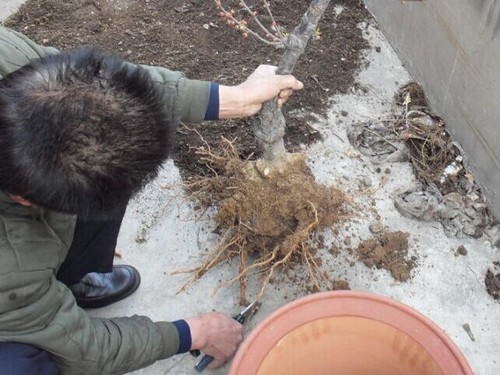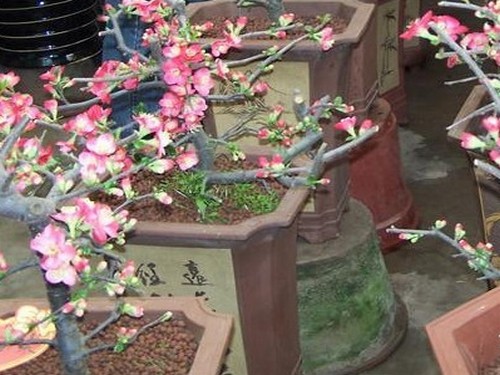Propagation technique of Prunus mume
The seeds of Prunus mandshurica generally mature in the middle of August, and can be harvested when the pericarp is orange-yellow or red-yellow, then the harvested fruit is cooled and dried, screened and stored in a sack or in a transparent container and stored in a cool, dry and ventilated place.

The propagation of Prunus mandshurica can be done by grafting, sowing and striping, but the effect of grafting is the best. It only takes two or three years to grow into a plant, blossom and bear fruit. There are two main grafting methods: cutting and budding. Mountain peach, elm leaf plum seedlings and apricot can be selected as rootstocks. Rootstocks generally need to be cultivated for more than two years, and the base diameter should be about 1.5 cm. The stump of 5 to 7 cm on the surface of the ground should be retained before grafting.
The main results are as follows: 1. From the end of August to the middle of September, the bud position should be fixed on the branch selected in advance as scion. The bud should be stout, fat and free from dry tip and insect pests. Use a sterilized bud grafting knife to cut upward into the xylem at an angle of 30 degrees 2 cm below the bud position, up to 1 cm above the bud position, then cut the grafting bud gently at the top of the bud position (1 cm). Cut a "T" shape on the bark with a knife 3 cm above the surface of the rootstock, with a length × width of 3 cm × 2 cm, gently uncover the bark and insert the buds into the "T" cut. Connect the buds closely with the rootstock, and then cut the plastic belt into a narrow band and tie it up. After grafting, the bud did not wilt in about 7 days, indicating that it has survived, and the plastic belt can be removed in about 20 days.
2. branch grafting in mid-and early March of spring, take the branch of one-year-old double elm leaf plum as scion, about 8 cm long, need to retain 3 or 4 buds, cut about 4 cm vertically between xylem and bark with a knife on one side of the cross section of the rootstock, cut the lower end of the scion into a duck's mouth shape, about 3.5 cm long, then insert the scion vertically into the cut of the rootstock, slightly "expose white", and then wrap it tightly with plastic tape. In order to moisturize, you can immediately cultivate the soil around it, and it will survive in about 20 days. After a month, gently remove the soil and remove the plastic belt.
Prunus mandshurica can be propagated by grafting, striping, cutting, sowing, dividing plants and so on. Most of them were propagated by ramet and grafting.
There are two kinds of grafting methods: bud grafting and branch grafting, and bud grafting is generally used. Budding should be carried out in the middle and last ten days of August. Rootstocks can use annual seedlings of elm leaf plum, or seedlings of wild roses, hairy peaches and mountain peaches. Bud grafting can choose to cut the full leaf buds from the annual branches from the excellent varieties of elm leaf plum. The technical connection should be carried out from February to March in spring. The scion should be cut before the plant sprouts. Winter tenacity can also intercept scions and store them in sandy soil for use in spring. The striping should be carried out from February to March in spring. Two-year-old branches can be selected and partially scratched or ring-peeled in the part buried in the soil to facilitate sprouting roots. It usually takes a month to take root. The seedlings of 1-2-year-old mountain apricot, mountain peach and elm leaf plum were used as rootstocks for grafting. The buds were cut before sprouting in spring; the buds were grafted from July to August; the buds could be grafted before June and could be separated from the mother plant after 1-2 months of healing. The seeds are sown in autumn after maturity or in spring after sand storage. It can be planted after defoliation in autumn to before bud germination in early spring. In the cultivation and management, attention should be paid to pruning and fertilization after anthesis to ensure that there are enough flower branches in the coming year.
The ramet method can be carried out before plant germination after soil thawing in autumn and spring. After ramet, 2 branches should be cut off to reduce water evaporation, which is beneficial to the survival of the plant.
There are two kinds of sowing and reproduction of elm leaf plum: autumn sowing and spring sowing.
Autumn sowing, that is, sowing on demand. Autumn sowing is mostly carried out in the middle or late October, but strip sowing is the best. Generally, the sowing depth is 2-3cm, the sowing width is 30-35cm, and the sowing rate per hectare is 150kg. Autumn sowing seeds do not need to be germinated beforehand, and clean and purified seeds can be sowed directly, but autumn sowing seeds do not germinate in the same year and need to overwinter in the nursery. However, before sowing the seeds, soak the seeds with 0.5% potassium permanganate solution for 2-3 hours, or soak the seeds with 3% concentration of 40min, seal the seeds for half an hour, rinse the seeds with clean water several times, sow the seeds, and then irrigate the seeds in time to survive the winter.
Spring sowing. The spring sowing of Prunus mandshurica is usually carried out in late April or early May after soil thawing. Before sowing, the seeds stored in winter were screened and purified, soaked in 40 ℃ warm water for 2-4 hours, mixed with 1-2 times amount of wet sand, accumulated in indoor or shed kiln to accelerate germination, turned once every 4-5 hours, when 40% of the seeds were broken and germinated, they could be planted. Specific methods: according to the 60cm row spacing north-south or east-west trench, ditch depth 2-3cm, and then the seeds according to 3-5cm interval, evenly distributed in the ditch, and then from both sides of the sowing ditch covered with soil, then gently suppressed around the foot permeable.
Time: 2019-06-11 Click:
- Prev

Know the prevention and control methods of edible fungus diseases, simplify and innovate the seed production of edible fungi.
Simplified and innovative method of seed production of Edible Fungi
- Next

Cutting technique of Prunus mume
Prunus mandshurica is an important early spring flowering tree species in gardens in North China. Although it is strong in nature and easy to cultivate, its management in spring can not be relaxed. If we do not pay attention to the management in spring, it will result in neither luxuriant trees nor numerous flowers, which will affect the ornamental effect. Elm leaf plum has been cultivated in China for hundreds of years.
Related
- Fuxing push coffee new agricultural production and marketing class: lack of small-scale processing plants
- Jujube rice field leisure farm deep ploughing Yilan for five years to create a space for organic food and play
- Nongyu Farm-A trial of organic papaya for brave women with advanced technology
- Four points for attention in the prevention and control of diseases and insect pests of edible fungi
- How to add nutrient solution to Edible Fungi
- Is there any good way to control edible fungus mites?
- Open Inoculation Technology of Edible Fungi
- Is there any clever way to use fertilizer for edible fungus in winter?
- What agents are used to kill the pathogens of edible fungi in the mushroom shed?
- Rapid drying of Edible Fungi

